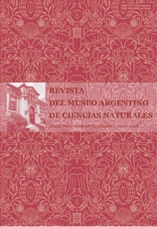Algas Chlorococcales como indicadores paleoambientales: nuevos datos de la Formación Los Rastros, Triásico del centro-oeste de Argentina
Resumen
Chlorococcalean algae as palaeoenvironmental indicators: new data from the Los Rastros
Formation, Triassic of central-western Argentina. Lacustrine strata of the Los Rastros Formation
(Triassic) at the Ischigualasto Provincial Park section, San Juan province, yield a distinctive palynological
assemblage of miospores and Chlorococcalean algae. The miospore association is characterized by a relative
abundance of corystosperm pollen grains with subordinate spores and inaperturates, diploxylonoid disaccates,
monocolpates, monosaccates and striate pollen grains. The phytoplankton is represented by the Chlorococcalean
Botryococcus and Plaesiodictyon. Geological data and variations in phytoplankton content indicate that the
lacustrine system should be moderately eutrophic towards the lower third of the section, evolving into a body
with oligotrophic conditions through the middle and upper part of the unit. Comparisons with the Río Gualo
section suggest palaeoenvironmental similarities between the two areas. One new disaccate pollen grain species,
Platysaccus rhombicus, is proposed.
Formation, Triassic of central-western Argentina. Lacustrine strata of the Los Rastros Formation
(Triassic) at the Ischigualasto Provincial Park section, San Juan province, yield a distinctive palynological
assemblage of miospores and Chlorococcalean algae. The miospore association is characterized by a relative
abundance of corystosperm pollen grains with subordinate spores and inaperturates, diploxylonoid disaccates,
monocolpates, monosaccates and striate pollen grains. The phytoplankton is represented by the Chlorococcalean
Botryococcus and Plaesiodictyon. Geological data and variations in phytoplankton content indicate that the
lacustrine system should be moderately eutrophic towards the lower third of the section, evolving into a body
with oligotrophic conditions through the middle and upper part of the unit. Comparisons with the Río Gualo
section suggest palaeoenvironmental similarities between the two areas. One new disaccate pollen grain species,
Platysaccus rhombicus, is proposed.
Texto completo:
PDFEnlaces refback
- No hay ningún enlace refback.

This work is licensed under a Creative Commons Attribution 3.0 License.

